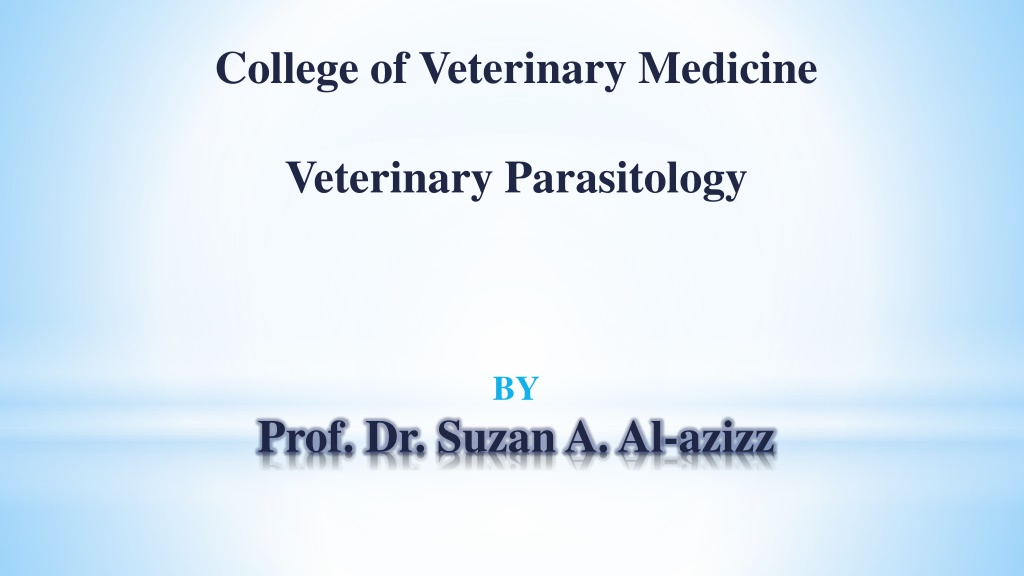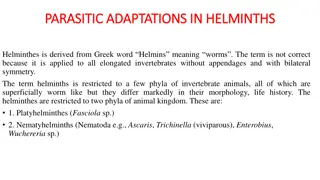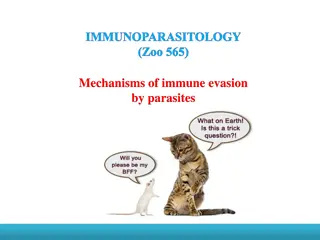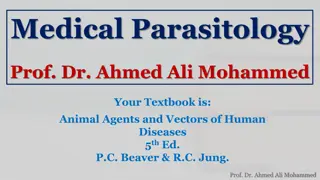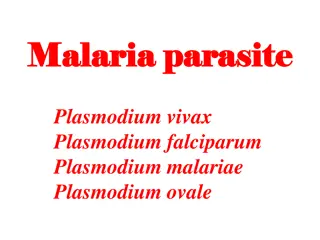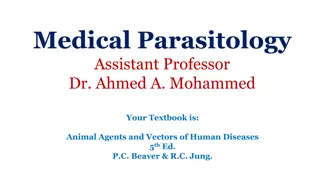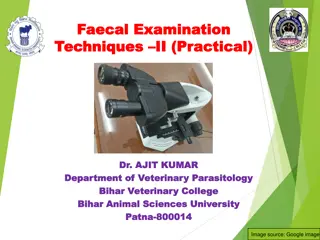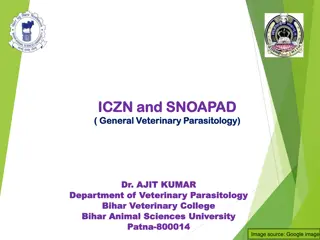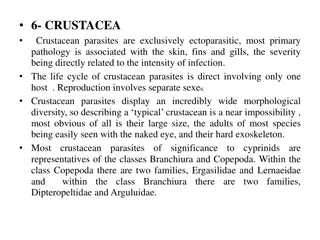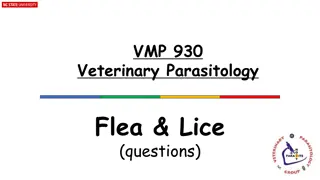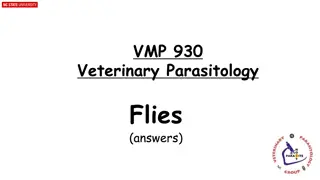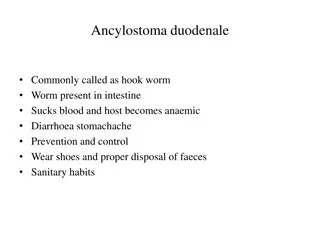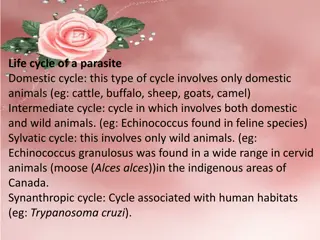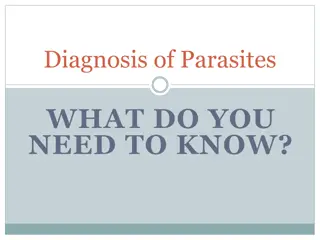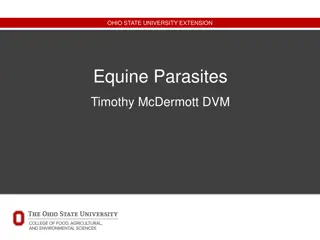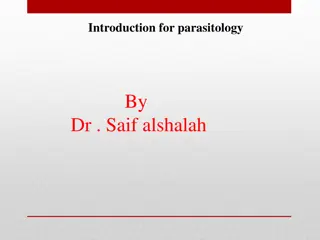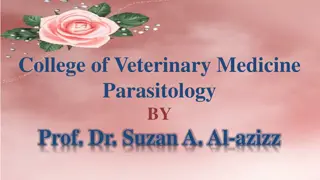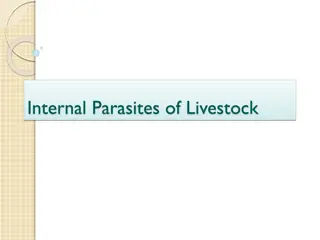Understanding Sarcocystis Parasites in Veterinary Parasitology
Veterinary Parasitology delves into the study of Sarcocystis parasites, focusing on their morphology, life cycle, and impact on hosts. The Sarcocystidae family, including species like Sarcocystis hominis and S. suihominis, are examined for their pathogenicity in carnivores and herbivores, shedding light on the complex interactions of these parasites within different host species.
- Veterinary Parasitology
- Sarcocystis Parasites
- Sarcocystidae Family
- Host-Parasite Interactions
- Veterinary Medicine
Download Presentation

Please find below an Image/Link to download the presentation.
The content on the website is provided AS IS for your information and personal use only. It may not be sold, licensed, or shared on other websites without obtaining consent from the author. Download presentation by click this link. If you encounter any issues during the download, it is possible that the publisher has removed the file from their server.
E N D
Presentation Transcript
College of Veterinary Medicine Veterinary Parasitology BY Prof. Dr. Suzan A. Al-azizz
cartoon_doctor_001 Genus Sarcocystis sp. Phylum: Apicomplexa Class: Sporozoea Subclass: Coccidia Order: Eucoccidiida Suborder: Eimerina Family: Sarcocystidae Genus: Sarcocystis Species : Sarcocystis sui, hominis, suihominis Host range: Parasites of this genus occur in carnivores (definitive hosts) and herbivores (intermediate hosts). Members of this genus are generally nonpathogenic in the definitive host, but highly pathogenic to the intermediate host. Species in this genus infect reptiles, birds and mammals. Site of infection: Sarcocystes are nearly always in skeletal muscle or esophageal muscle.
Morphology Oocyst: containing two sporocysts each one contain 4 sporozoites. The oocysts produced in the intestine of the carnivore definitive host will sporulated immediately (in the host s intestine) and the fragile oocyst wall will usually rupture (again while still in the host), thus the diagnostic stage is the sporocysts(containing 4 sporozoites). Sporocysts: It is oval shaped; each sporocyst contains four banana-shaped sporozoites. Mature sporocysts are infective stage to other susceptible hosts. Sporozoites: morphology is very similar to that for bradyzoites. Sarcocystes or Miescher's tube: This is spindle shaped structure with thick striated wall ( are present in the bovine skeletal muscles), In the middle of the Miescher's tube there are large numbers of merozoites called bradyzoites, which are fusiform, elongated &cylindrical .The tube is divided into many compartment by septa. While in the periphery ,there is usually a rounded fully developed cells called metrocystes. Bradyzoites: have distinct anterior and posterior ends. Gamonts: macrogamonts are rounded and microgamonts are elongated or slender with bi- flagellated.
Sarcocyctidae Family Many types are described within this family and most of them are found in the muscles of herbivores, birds and humans. Sarcocystis hominis and S. suihominis use humans as definitive hosts and are responsible for intestinal Sarcocystosis in the human host. Humans may also become dead-end hosts for non- human Sarcocystis spp. after the accidental ingestion of oocysts. It is found in the striated muscles of herbivores, birds and humans. It was isolated for the first time from the pig and was believed to be a species of fungi, but it was then found in lamb and geese. This has led to the assumption that it is a genus of fungi, but recent studies have confirmed that it is a subordinate organism with links to Toxoplasma sp. confusedman
The organisms called Miesher's tubes are easily seen as spindle or cylindrical structures located in the muscle bundles and vary greatly in size from a few millimeters to a few centimeters in length. The basis for this parasite to be enveloped in the wall of a sac that creates walls inside it. The parasite is divided into a number of rooms and when it ripens, it is full of types and activists that have the shape of a banana fruit. Provided with hollow ridges that help the parasite to contact the host's tissues. The cyst is divided into large numbers of chambers whose walls are formed by the protrusion of the granular inner layer of the cyst wall which shows connections with the hollow surface protrusion. The activist is covered with a two-layer cortex and in the front third there is a fibrous band with a well developed front cone, the cone is covered with a polar ring within the cortex extending from 22-26 fibers to the back along the spore body under the two-layer cortex.
The anterior third of the spore is filled with a large number about 350 parallel fibers or channels called sarconemes, which arise from the conical part of the spore and end up with about one third of the body. Also, in the middle of the spore there are a large number of central circular granules, and other granules containing RNA, some of which contain Volutin and are located The nucleus is in the posterior third of the body. Finally, they are granular and enclosed in a double nuclear membrane and contain a few chromatin granules and an internal particle. Also around the nucleus there is a large number of granules and gaps, some of which contain cyclogen, during which mitochondria are located. Geographic Distribution Worldwide, but more common in areas where livestock is raised.
Life Cycle: Infection is believed to occur by eating animals with muscle bags in a role in the animal s feces. The intestine is an important part of the developmental cycle with no evidence of a medial host or a transporting insect, as the infective or active role passes through the intestinal wall and is carried in the bloodstream to the various striated muscles in the body. The first roles are discovered after about 6 weeks or more on infection, and it is composed of a single-celled Namibian parasite, and then the nucleus takes a series of binary fission to form a number of rounded cells with the nucleus called Speroblast and all of them are surrounded by the cyst wall. The fission process continues to be elliptical forms and thus banana-like forms (active). As the number increases, the cyst widens in size, then the parasite is divided by growths towards the inside of the cyst wall into rooms or gaps and the process continues and the cyst grows into gas layers at the edge of the cyst and the activists accumulate inside the cyst . Pathology The types of Sarcocystis are not of serious nurse importance in live animals, and flesh intended for human consumption is destroyed if infected with the parasite.
Clinical Signs: In cases of intestinal sarcocystosis, when humans serve as the definitive hosts, infections are often asymptomatic and clear spontaneously. Occasionally, mild fever, diarrhea, chills, vomiting and respiratory problems may occur. When humans become infected with sarcocysts of non-human species, the infections are not intestinal but rather result in muscle cysts; symptoms such as myalgia, muscle weakness and transitory edema may occur. In these cases, humans are dead-end intermediate hosts. Miesher's tubes
